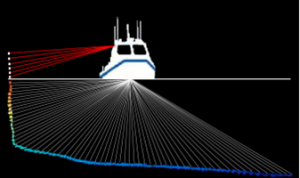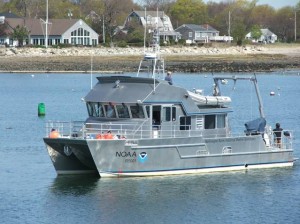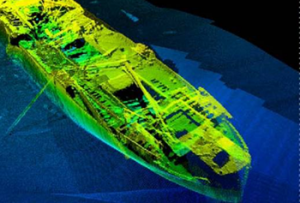The Middlebury Campus has published an interview with me about the R/V David Folger. Check it out!
Category Archives: Beginnings
MRI grant awarded!
We’ve just been notified that our MRI proposal will be funded! This new NSF grant will be used to purchase the multibeam sonar and underway ADCP we requested last January. We worked very carefully with AAM and all of the equipment vendors to ensure that every expense related to purchasing, installing, and verifying this new equipment on the vessel could be provided through the MRI grant. No vessel contingency funds will be needed.
We are elated. This vessel will be capable of so much — the possibilities are really thrilling!
Rounding up local support for the MRI proposal
We’re sending email today to several of our colleagues who do research on Lake Champlain, to demonstrate support for our MRI proposal. All of them could potentially expand their reach with the tools we’re requesting, so we’re asking for confirmation that they’d want to use these capabilities (and how). If we do get these instruments, we’ll be able to plan joint surveys, for example, to map Missisquoi Bay, Cumberland Head, or trout spawning grounds. The local researchers we hope to work with include Bill Howland at the Lake Champlain Basin Program, Tim Mihuc at SUNY Plattsburgh, and Greg Druschel, Andrea Lini, and Mary Watzin at the University of Vermont.
Happy holidays…
NSF has approved Dave Weed as our marine inspector. Dave was the best match out of several inspectors we interviewed, so we’re very pleased to have him on board! The contract for Richard Furbush, who will captain the new vessel, was approved and signed back in October; he’ll be working with Dave during the construction process.
The aluminum for the vessel has also been ordered. It will arrive at AAM in plenty of time to meet their January schedule.
Tom and I will be teaching at Middlebury’s California campus — the Monterey Institute for International Studies — this Winter Term.
Looks like all the hatches are battened for now — peace on earth & goodwill to all! I’ll see you in the New Year.
Gearing up for another major proposal
Tom and I have decided to submit another proposal to the NSF in January. This one is an application for a grant through the MRI program to purchase a multibeam sonar/ADCP (acoustic Doppler current profiler) system to support educational and research activities on Lake Champlain. The multibeam sonar is a real-time swath-mapping acoustic tool that can do extremely detailed bottom mapping – much better than the side-scan sonar we currently use. It gathers data 70 degrees on either side of the boat within 0.25 – 1.0 m horizontal cells and 2-10 cm in the vertical!

As its name suggests, multibeam sonar works by bouncing multiple sonar beams off the area being surveyed.
As educators, we hope to upgrade the technology and investigative programs we can provide to students in the region. And as researchers we have been slowly changing the focus of our work, from large-scale systems to medium- and small-scale sediment and circulation dynamics. In these smaller systems, even the best bottom bathymetry that we have now is lacking, because it’s based on track-line measurements taken more than 150 meters apart. That’s better than the old lead-line data, but not good enough to produce the detail needed for today’s geodynamic research. For example, our current instruments just can’t capture the deep circulation in the lake around and over sediment drifts, underwater slumps and landslides (which we are seeing more often), subsurface terraces and river channels, fine details of the many pock marks around Burlington and Cumberland Head, sediment furrows, and countless other features.
The multibeam instrument is capable of collecting vastly improved bottom bathymetry that would benefit many other lake researchers in the region, so we hope to recruit our colleagues’ support for this proposal. The ADCP provides a quick and reliable look at the currents every few seconds. It can collect water-velocity data from ~1 meter below the sensor to depths of up to 70 meters every 1 meter (sometimes less) in the vertical – while the vessel is moving!
Finally under way
NSF has approved the College’s contract with AAM. Now the real work begins!
Getting the word out
Sarah Ray and I have co-written a press release about the new research vessel — read all about it!
All American Marine to build new research vessel
 It’s official: All American Marine will build Middlebury’s new research vessel. The vessel will be twin hulled — a catamaran — and 45 feet long. Middlebury’s research vessel will be very similar its sister ship, the R/V AUK (pictured here), which AAM built for the National Oceanic and Atmospheric Administration (NOAA). Of the eight ship builders who sent us proposals in 2008, AAM was the best: their design and construction capabilities are superior, and the level of detail they provided convinced us that they are the right choice.
It’s official: All American Marine will build Middlebury’s new research vessel. The vessel will be twin hulled — a catamaran — and 45 feet long. Middlebury’s research vessel will be very similar its sister ship, the R/V AUK (pictured here), which AAM built for the National Oceanic and Atmospheric Administration (NOAA). Of the eight ship builders who sent us proposals in 2008, AAM was the best: their design and construction capabilities are superior, and the level of detail they provided convinced us that they are the right choice.
Official award notification
It’s finally official! The award letter has arrived:
The National Science Foundation hereby awards a grant of $1,731,377 to Middlebury College for support of the project described in the proposal referenced above as modified by revised budget dated July 13, 2010.
This project, entitled “Upgrading Middlebury College’s Floating Laboratory: A State-of-the-Art Research Vessel,” is under the direction of Patricia L. Manley, James R. Ralph, Robert G. Cluss, Thomas O. Manley. This award is effective August 1, 2010 and expires July 31, 2013. This award is funded under the American Recovery and Reinvestment Act of 2009 (ARRA) (Public Law 111-5).
NSF responds
We’ve gotten the first feedback from the National Science Foundation on our Project Execution Plan: revisions are needed. Many questions to resolve, and they want us to cut the budget.

